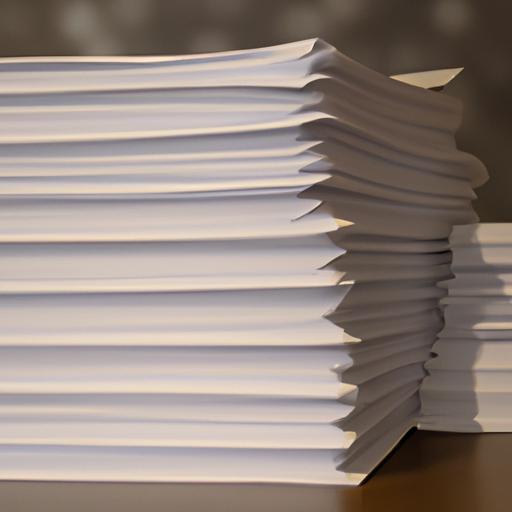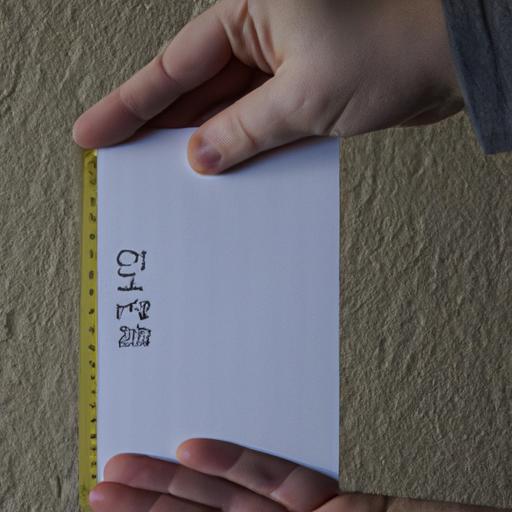How Big is a Normal Piece of Paper?
Table of Contents
Introduction

When it comes to paper, size matters. Knowing the standard size of paper is essential for a variety of applications, from printing documents to creating art. The most common question asked is “how big is a normal piece of paper?” In this article, we will explore the different sizes of paper, including international and North American standards, as well as other paper sizes you may encounter. We will also discuss paper thickness and weight, and how to choose the right paper for your needs.
International Standard Paper Sizes
The International Organization for Standardization (ISO) has established a standard for paper sizes known as ISO 216. This standard is used in most countries worldwide, except for the United States and Canada. The standard is based on the A series, which includes A0, A1, A2, A3, A4, A5, A6, A7, A8, A9, and A10 sizes. The dimensions of each size are based on a ratio of the length to the width, with the length being the longer side.
Common ISO Paper Sizes
- A4: This is the most common paper size worldwide, measuring 210mm x 297mm or 8.27 inches x 11.69 inches. It is used for printing documents, letters, and resumes.
- A3: This size is twice the size of A4, measuring 297mm x 420mm or 11.69 inches x 16.54 inches. It is commonly used for printing posters and artwork.
- A5: This size is half the size of A4, measuring 148mm x 210mm or 5.83 inches x 8.27 inches. It is commonly used for printing booklets and flyers.
- A6: This size is half the size of A5, measuring 105mm x 148mm or 4.13 inches x 5.83 inches. It is commonly used for printing postcards and notepads.
- A7: This size is half the size of A6, measuring 74mm x 105mm or 2.91 inches x 4.13 inches. It is commonly used for printing business cards and invitations.
Knowing the different ISO paper sizes can help you choose the right size of paper for your needs, whether you are printing documents, artwork, or marketing materials. The next section will explore the standard paper sizes used in North America.
North American Standard Paper Sizes
The United States and Canada use a different standard for paper sizes than the rest of the world. The most commonly used standard is the Letter size, which measures 8.5 inches x 11 inches. This size is used for printing documents, letters, and resumes. Another common size is the Legal size, which measures 8.5 inches x 14 inches. This size is used for legal documents and contracts.
Another North American standard paper size is the Tabloid size, also known as Ledger size, which measures 11 inches x 17 inches. This size is commonly used for printing newspapers, magazines, and posters. Other North American paper sizes include the Junior Legal size, which measures 5 inches x 8 inches, and the Government Letter size, which measures 8 inches x 10.5 inches.
Understanding the different North American standard paper sizes can help you choose the right size of paper for your needs, whether you are printing legal documents or creating marketing materials. In the next section, we will explore other paper sizes you may encounter.
North American Standard Paper Sizes
In addition to the Letter, Legal, and Tabloid sizes, there are other standard paper sizes used in North America. The Junior Legal size, which measures 5 inches x 8 inches, is commonly used for notepads and small notebooks. The Government Letter size, which measures 8 inches x 10.5 inches, is used for official government documents.
Another North American standard paper size is the Executive size, which measures 7.25 inches x 10.5 inches. This size is commonly used for resumes and business letters. The Ledger size, which measures 17 inches x 11 inches, is used for larger documents, such as spreadsheets and architectural drawings.
Understanding the different North American standard paper sizes can help you choose the right size of paper for your needs, whether you are printing official documents, resumes, or spreadsheets.
Other Paper Sizes
Apart from the international and North American standard paper sizes, there are other paper sizes you may encounter in your daily life. These sizes are commonly used for special applications, such as envelopes, postcards, cards, and labels.
Envelope Sizes
Envelopes come in different sizes to accommodate different types of documents, from letters to invitations. The most common envelope sizes include:
- A2: Measures 4.375 inches x 5.75 inches
- A6: Measures 4.75 inches x 6.5 inches
- A7: Measures 5.25 inches x 7.25 inches
- A9: Measures 5.75 inches x 8.75 inches
-
10: Measures 4.125 inches x 9.5 inches
Postcard Sizes
Postcards are a popular way to send greetings, invitations, or announcements. The most common postcard sizes include:
- 4 inches x 6 inches
- 5 inches x 7 inches
- 6 inches x 9 inches
Card Sizes
Cards are commonly used for greeting cards, invitations, and announcements. The most common card sizes include:
- A2: Measures 4.25 inches x 5.5 inches
- A6: Measures 4.5 inches x 6.25 inches
- A7: Measures 5 inches x 7 inches
- A9: Measures 5.5 inches x 8.5 inches
Label Sizes
Labels are used for a variety of applications, from addressing envelopes to organizing files. The most common label sizes include:
- 2.625 inches x 1 inch
- 4 inches x 2 inches
- 4 inches x 3.33 inches
Understanding the different paper sizes for envelopes, postcards, cards, and labels can help you choose the right size for your needs, whether you are printing invitations, addressing envelopes, or organizing files. In the next section, we will discuss paper thickness and weight.
Paper Thickness and Weight
When it comes to choosing the right paper for your needs, it’s essential to consider both the thickness and weight of the paper. The thickness of paper is measured in points, with one point equaling 1/1000th of an inch. The weight of paper is measured in pounds per ream, with one ream equaling 500 sheets of paper.
Understanding Paper Thickness
Paper thickness can affect the look and feel of your printed materials. For example, thicker paper can give a more luxurious and professional look to business cards and invitations. On the other hand, thinner paper is more suitable for everyday documents and flyers. When choosing paper thickness, it’s important to consider the printer’s specifications and the type of printing you will be doing.
Understanding Paper Weight
Paper weight can affect the durability and quality of your printed materials. Heavier weight paper is more durable and suitable for printing materials that will be handled frequently, such as brochures and business cards. On the other hand, lighter weight paper is more suitable for everyday documents and letters. When choosing paper weight, it’s important to consider the printer’s specifications and the type of printing you will be doing.
How to Choose the Right Paper Thickness and Weight
To choose the right paper thickness and weight, consider the purpose of your printed materials, the printer’s specifications, and the type of printing you will be doing. For example, if you are printing a high-quality brochure, you may want to choose a heavier weight paper with a glossy finish. On the other hand, if you are printing everyday documents, you may want to choose a thinner paper with a matte finish.
Conclusion
In conclusion, understanding the standard sizes of paper and the different paper thicknesses and weights available can help you choose the right paper for your needs. Whether you are printing documents, artwork, or marketing materials, choosing the right paper can affect the look, feel, and durability of your printed materials. By considering the purpose of your materials, the printer’s specifications, and the type of printing you will be doing, you can choose the right paper to make your printed materials stand out.

